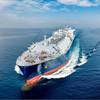With several major investors in container shipping being driven from the industry in 1999 by the long term record of inadequate returns, it appears that carriers are no nearer to solving the riddle of how to turn growth into profit
A new report from Drewry Shipping Consultants Ltd., titled "Container Market Outlook," estimates that in 1998 carriers lifted 14.7 percent more cargo than in 1996 (more than 7.2 million teu), but somehow contrived to earn 1.2 percent less revenue. All the additional traffic was essentially carried not just freight free, but actually with a subsidy from lines
Industry profitability has also declined, with the Asian crisis making 1998 a particularly bad year, and on the main east-west trades Drewry estimates aggregate carrier losses at almost $2.4 billion - a negative margin of more than eight percent.
In 1999, carriers, driven perhaps by desperation, have addressed the revenue gap with more aggression than ever before. Massive rises on Asian export trades have been coupled with an increasing array of surcharges and tentative efforts to restore Asian import rates and to stem losses on the Transatlantic. Drewry's "Container Market Outlook" report assesses the net turnaround for carriers in 1999 at almost the entirety of the 1998 loss with the transpacific trade improving by $2.2 billion and Europe-Far East by $600 million, but in the transatlantic, aggregate carrier profitability is estimated to have declined by more than $500 million.
Despite the regular under-performance of the carrier sector and the exit of many well known names, there are those still eager to challenge the received industry wisdom about high barriers to entry, and China Shipping Group has made a particularly eye-catching assault on the Asian east-west trades. Thus, while Maersk has paid over $1 billion in 1999 for Sea-Land and Safmarine, the competition hardly lessens at all, and consolidation continues to be a slow and drawn-out process, though logic suggests it is the main route for the industry to pursue.
If carriers are looking to higher rates to lead the industry to long-term profitability, the evidence of the last 20 years suggests that they will be disappointed.
The current successes in raising average rates on certain legs of certain trades are unlikely to be sustainable, since there are many powerful influences working to keep rates low.
Even during 1998-99, global average rates have largely continued to fall, since favorable market opportunities arising from severe trade imbalances will, by definition, be matched against weaknesses on the return legs.
Any long-term strategy that largely or exclusively depends on space shortages to raise rates will not work. Carriers need to use the new possibilities provided by deregulation to break out of the market-driven cycle, since this is a battle that history indicates they cannot win.
The "Container Market Outlook" report can be ordered by contacting Paula Puszet at Drewry Shipping Consultants Ltd., Meridian Gate - South Quay, 213 Marsh Wall, London E14 9FJ, England or by e-mail at [email protected]. - (Drewry Shipping Consultants Ltd.)
Sponsored Content
Experience Custom Yacht Signs and Designs Tailored to Perfection!

April 2025
 Read the Magazine
Read the Magazine

 Read the Magazine
Read the Magazine
This issue sponsored by:

Looking Back: U.S. Maritime Industry Steps Up in Wake of FSK Bridge Collapse
Subscribe for
Maritime Reporter E-News
Maritime Reporter E-News is the maritime industry's largest circulation and most authoritative ENews Service, delivered to your Email five times per week









